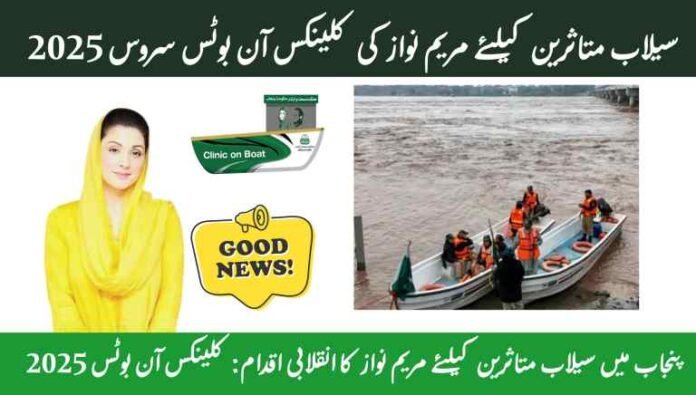Contents
When Punjab’s most devastating floods in decades submerged villages and cut off entire districts, thousands of families found themselves without access to hospitals or doctors. In response, Chief Minister Maryam Nawaz has unveiled an unconventional yet practical solution: Clinics-on-Boats 2025 – a fleet of floating medical units designed to bring healthcare directly to stranded communities.
A Hospital That Floats to the Patient
The idea behind the project is straightforward: if patients can’t reach hospitals, the hospitals will reach them. Ordinary boats have been refitted as mobile clinics, each staffed with doctors, nurses, and medical technicians. They carry essential medicines, vaccines, and diagnostic equipment to ensure flood-hit residents don’t go untreated.
This approach isn’t just about convenience. With roads washed away and local facilities overwhelmed or destroyed, the boats are often the only lifeline for families stuck in isolated areas.
Why the Program Is Urgent
According to government figures, the floods have displaced over 36,000 people and damaged nearly 5,000 villages. The aftermath has also triggered a surge in waterborne diseases like cholera and malaria, alongside food shortages and maternal health risks. Children and pregnant women, in particular, face life-threatening conditions without access to care.
The floating clinics are meant to fill this critical gap, offering everything from routine check-ups to emergency referrals.
Who Can Use the Service?
There’s no paperwork or online registration involved. Any resident of Punjab’s flood-affected districts can receive treatment, with special priority given to:
- Women, especially expectant mothers
- Infants and young children
- The elderly
- Patients with long-term illnesses
What the Clinics Provide
Each boat is a compact but fully functional health unit. Services include:
- Maternal care: pregnancy check-ups, nutrition kits, and emergency transfers
- Pediatric support: vaccinations, malnutrition screening, and treatment for common childhood diseases
- Infectious disease treatment: cholera, malaria, diarrhea, and skin infections
- Free essential medicines: antibiotics, ORS, pain relief, antiseptics
- Emergency response: 24/7 ambulance transfers for critical cases
How Access Works
The process is deliberately simple. The government identifies high-need zones, dispatches the clinics, and residents can approach them directly. For severe cases, patients are transported to nearby hospitals through a linked ambulance service.
Unlike typical relief schemes with deadlines, this service will remain active until floodwaters subside and regular healthcare facilities are back in operation.
Beyond Flood Relief: A Wider Vision
Maryam Nawaz has framed the initiative as part of a broader social agenda that includes affordable healthcare through permanent health clinics, food price controls, and stronger disaster-response systems. The floating clinics, she argues, are not just temporary relief but a model for ensuring resilience during future crises.
Setting a New Standard
Punjab’s Clinics-on-Boats Service may look like an emergency fix, but it carries larger implications. In a province where climate-driven disasters are becoming more frequent, such innovations highlight how governance can adapt quickly to protect the most vulnerable.
By sending medical care directly onto the waters, Punjab has effectively rewritten the playbook on disaster health response.


